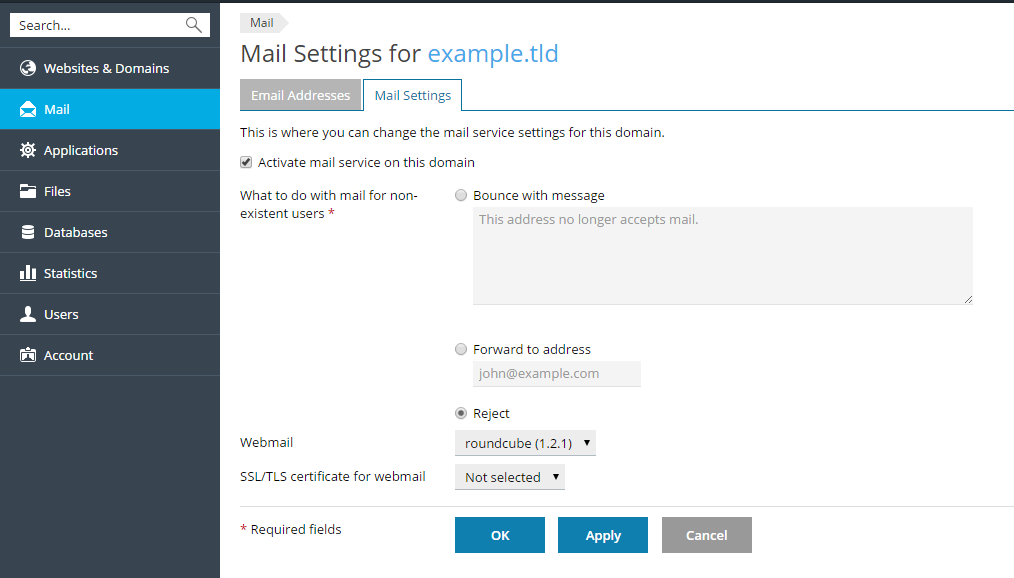Postfix Configuration File Plesk Server
Postfix Configuration File Plesk Panel Support Postfix with Plesk « Datanet Hosting Solutions Datanet Hosting Solutions. Postfix configuration files are in /etc/postfix. DKIM configuration for Postfix & Plesk. After any changes to OpenDKIM configuration file. PostFix Local. DKIM on a Debian server with Postfix.

Free Download Kubera Lakshmi Mantra Mp3 here. Postfix Basic Configuration Postfix Basic Configuration Introduction Postfix has several hundred configuration parameters that are controlled via the file. Fortunately, all parameters have sensible default values.
In many cases, you need to configure only two or three parameters before you can start to play with the mail system. Here's a quick introduction to the syntax: • The text below assumes that you already have Postfix installed on the system, either by compiling the source code yourself (as described in the file) or by installing an already compiled version. This document covers basic Postfix configuration. Information about how to configure Postfix for specific applications such as mailhub, firewall or dial-up client can be found in the file. But don't go there until you already have covered the material presented below. The first parameters of interest specify the machine's identity and role in the network.
Emerson Lake And Palmer Trilogy Rar File. • • • • • The default values for many other configuration parameters are derived from just these. The next parameter of interest controls the amount of mail sent to the local postmaster: • Be sure to set the following correctly if you're behind a proxy or network address translator, and you are running a backup MX host for some other domain: • Postfix daemon processes run in the background, and log problems and normal activity to the syslog daemon. Here are a few things that you need to be aware of: • If your machine has unusual security requirements you may want to run Postfix daemon processes inside a chroot environment. • If you run Postfix on a virtual network interface, or if your machine runs other mailers on virtual interfaces, you'll have to look at the other parameters listed here as well: • • • By default, Postfix configuration files are in /etc/postfix.
The two most important files are and; these files must be owned by root. Giving someone else write permission to or (or to their parent directories) means giving root privileges to that person. In /etc/postfix/ you will have to set up a minimal number of configuration parameters. Postfix configuration parameters resemble shell variables, with two important differences: the first one is that Postfix does not know about quotes like the UNIX shell does. You specify a configuration parameter as: /etc/postfix/: parameter = value and you use it by putting a '$' character in front of its name: /etc/postfix/: other_parameter = $parameter You can use $parameter before it is given a value (that is the second main difference with UNIX shell variables).
The Postfix configuration language uses lazy evaluation, and does not look at a parameter value until it is needed at runtime. Postfix uses database files for access control, address rewriting and other purposes. The file gives an introduction to how Postfix works with Berkeley DB, LDAP or SQL and other types. Here is a common example of how Postfix invokes a database: /etc/postfix/: =:/etc/postfix/virtual Whenever you make a change to the or file, execute the following command as root in order to refresh a running mail system: # postfix reload The parameter specifies the domain that appears in mail that is posted on this machine. The default is to use the local machine name, $, which defaults to the name of the machine. Mikrotik Routeros Level 6 License Download Manager.
Unless you are running a really small site, you probably want to change that into $, which defaults to the parent domain of the machine name. For the sake of consistency between sender and recipient addresses, also specifies the domain name that is appended to an unqualified recipient address. Examples (specify only one of the following): /etc/postfix/: = $ (default: send mail as 'user@$') = $ (probably desirable: 'user@$') The parameter specifies what domains this machine will deliver locally, instead of forwarding to another machine. The default is to receive mail for the machine itself. See the file for how to configure Postfix for.
You can specify zero or more domain names, '/file/name' patterns and/or ' lookup tables (such as:,:, nis:,:, or:), separated by whitespace and/or commas. A '/file/name' pattern is replaced by its contents; ' requests that a table lookup is done and merely tests for existence: the lookup result is ignored. IMPORTANT: If your machine is a mail server for its entire domain, you must list $ as well. Example 1: default setting.